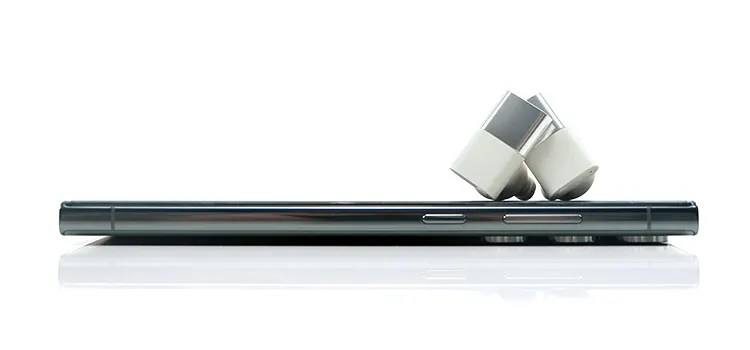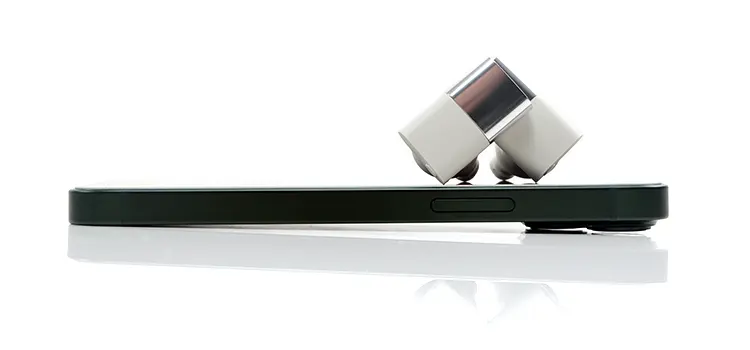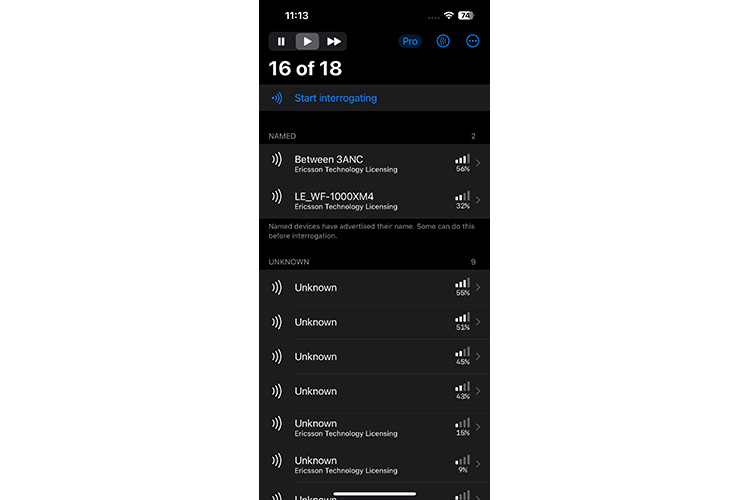Sound Impressions
Summary
Rather than a default “flat profile”, the Status Between 3ANC has 3 distinct tunings from the provided sound profiles within the app.
The Signature profile is ticked off as the default presentation and is V-shaped with a slight roll-off in the sub-bass, a punchy mid-bas bass, and forward vocal imaging. However, with a shade off the highs, it has a slightly smoother tonal coloration than the alternatives.
The “Audiophile Profile” is much flatter in its response but retains a fairly forward vocal image and a similar tuning in the highs to the Signature profile.
Here it seems everything south of around 500-700Hz retains a similar shape but has been dropped in amplitude or dB to reduce the presence in a fairly dramatic manner. This gives the mids and highs a much stronger focus but with less warmth and weight.
the final profile is a reproduction of the original Status Between Pro tuning. I have not heard the original TWS so I cannot confirm if an exact duplication but what you get here is a similar profile on the lows compared to the Signature EQ but with a livelier treble response curve from 7-10k.
This profile is more of a classic V-shaped high-energy high-contrast tonal coloration. It’s more vivid in the highs compared to the Signature but comes with a higher risk of fizz in percussion hits and natural vocal sibilance being emphasized.
Frequency Response
Signature
If we start with the Signature profile, the bass weight and punch are strong but with a slight roll-off below 60-70Hz reducing the sub-bass presence somewhat and instead giving it a punchy mid-bass character.
I wouldn’t say it’s sub-bass light though, rather the mid-bass is more pronounced and it does help ensure it’s not a slow bass. It also keeps a little warmth out of the equation, at least more so compared to something like the Sony WF-1000XM4 which has a richer heavier bass profile.
The upper bass is sucked out quite strongly to prevent bleed but it does mean lower register instruments will image quite far behind the mids which rise quite quickly from around 800Hz to 3k.
Vocal and midrange instrumental presence will come forward and resonate strongly alongside that mid-bass punch with higher register and lower-mid register instrumental positioned behind.
Beyond 6k it’s fairly linear but lower in dB amplitude which is where that slightly smoother tonal profile comes from when compared to the Between Pro profile. That in turn doubles down on the higher register spatial cue presence tucking in behind vocal performances.
Audiophile
With the Audiophile profile, the 1-3k pinna gain is retained but this time there is a flatter treble tuning with less of a 5k bump and sub 700Hz though roughly the same curve but with a big dB drop all the way down to 20Hz.
This is your mid-centric profile with the narrowest soundstage and lacking a bit of depth but also the smoothest sounding of the 3 pre-sets.
Between Pro
With the Between Pro profile, the FR is almost an exact match with the Signature up to 3k with less energy from 4-5k to just keep the brightness in the mids timbre in check from a stronger lift in the highs between 7-10k. This is the deepest V-shaped profile with the highest level of tonal contrast.
Custom EQ
One thing to note is the excellent responsiveness of the 3ANC to the custom EQ. I tend to work my own EQ for listening creating a fourth profile with stronger sub-bass and less mid-bass to enhance the perceived separation.
I also keep the stock pinna again as a vocal lover but drop the 5-6k range a bit and keep the 14k band a few dB higher. This keeps the profile clean but less sibilant with improved power and vocal presence. It also adds more of an airy spacious character to the soundstage with improved depth and height.
Timbre
With three tonal profiles, you do have a choice with the 3ANC with two V-shaped and one mid-centric. You can further temper the coloration with the app’s effective custom EQ options.
Of the three, the Signature and the Audiophile will give you the smoothest mids and highs timbre. The Between Pro will produce a brighter upper treble overtone which will add some sharpness and perceived clarity or energy to the upper mids.
The Pro and Signature will deliver the best fundamental with low register notes punchy and full sounding. The Between Pro Signature will raise the upper-order harmonics a bit more adding some enhanced edges to the notes whereas the Signature is a little softer and rounded in tonal quality.
Technically, the audiophile profile timbre is the smoothest with less elevation in the highs. Vocal quality is very evenly balanced and clear without any unnatural sibilant qualities. The only drawback is the bass weight lacking so lower register notes lack a bit of gravitas and power.
As a general theme throughout all the profiles, the BA timbre through the mids and highs is generally on the slightly drier side for all of the profiles. For the 2 profiles with a stronger bass presence, the ‘temperature’ is a bit cooler compared to the warmer but more languid dynamic driver tuning profiles from the Huawei FreeBuds 2 Pro and the Sony WF-1000XM4.
Staging & Dynamics
Vocals or the 1-3k range is really the main focus for me from the 3ANC along with the excellent mid-bass punch. Both balance off each other a bit and take center stage with instruments tucked well behind when up against competing TWS.
For the best depth and power with improved width and height then the Status and Between Pro sound profiles are an apt fit. Save for the sub-bass roll-off which you can EQ upwards if you need it, these two are the punchiest and probably best represent what the 3ANC is all about.
Of the two, the Between Pro pushes harder on the highs but I prefer the slightly softer quality of the naturally attenuated Signature Profile treble tuning and the better male vocal presence.
The Audiophile sound signature feels a little more intimate and closed in with the vocals pushed forward and not a huge amount of depth or sparkle. The bass response is a little too flat and will require some custom EQ just to give lower-mid instruments a bit more weight and presence.
I do like the treble tonal quality on this profile but if you are after extension and ethereal highs I would suggest going with the Between Pro which pushed the 7-10k a lot harder with more perceived headroom as a result.
Wireless Performance
All performance tests were conducted using a Windows 10 laptop, a Samsung S23 Ultra, and an Apple iPhone 13 Mini as the main transmitters combined with Bluetooth Meter for Android and BT Inspector for iOS.
Pairing
Pairing is very straightforward with the 3ANC for both Android and iOS. A quick scan will show the product name in the found list, (no left or right options unless you have only one driver powered up). From there simply click and connect.
One thing to note, you need to do that first before going into the Status app. The app will not find the 3ANC drivers when the pairing is not active. Once it is it will prompt you with a listing, which you then connect to get into the main screen.
Sadly, you have to do this every time you want to use the app which seems to be a redundant process. A one-time connection should be enough.
By the way, the voice actor for the status checks has Mathew McConaghy levels of ‘laid back’ with one of the cleanest voice prompts I have heard on a TWS.
Stability & Range
The stability and range of the 3ANC is excellent, one of the best TWS I have tested to date. I can go right to the far end of my apartment with no dropout whatsoever which is a very rare occurrence.
For reference that’s about 15-20 meters with 2 walls in between. I got the same result with both the iPhone 13 Mini and the Samsung S23 Ultra.
With BT inspector on the iPhone 13 Mini, the signal strength was very stable with the 3ANC and stronger compared to the Sony WF-1000XM4 from 3 meters away which was used as a point of comparison. The Sony stability and range I rank almost as good in my previous subjective testing so this is a high benchmark.
Latency
With a lack of the latest adaptive or latency-sensitive codecs, there is some noticeable large when using the 3ANC for general media in Windows 10. Using a mix of local media, YouTube and Netflix the amount of noticeable lag varied with the local media files doing best to Netflix, (Web), being pretty much unusable.
Sync tightness was much better on mobile platforms with both YouTube and Netflix quite useable with the 3ANC and with far less noticeable lag compared to Windows 10.
I wouldn’t have any issue using the 3ANC for general streaming media on the basis of that performance. However, for gaming, it will not be as tight as aptX LL or LDAC-equipped TWS. I would stick to general media and audio with the 3ANC.




